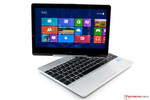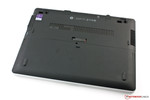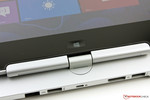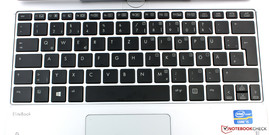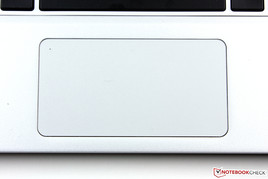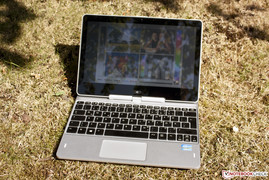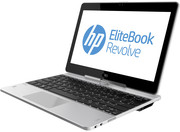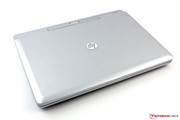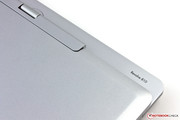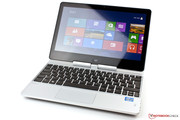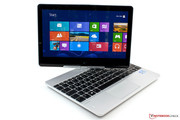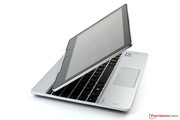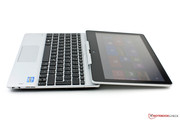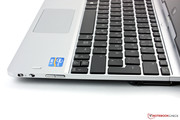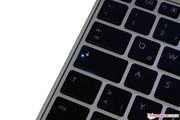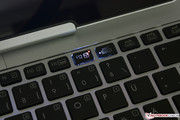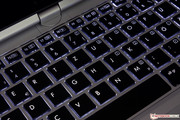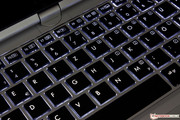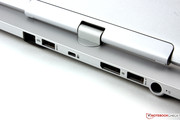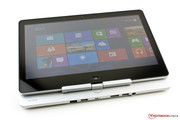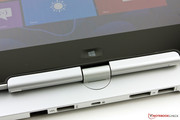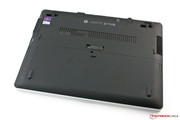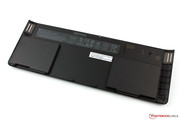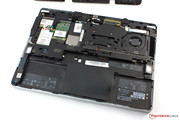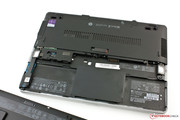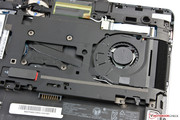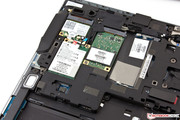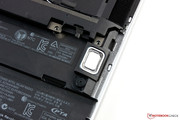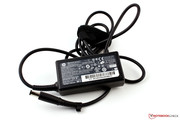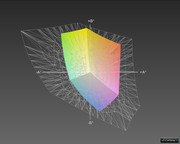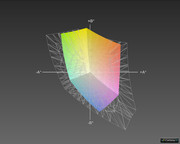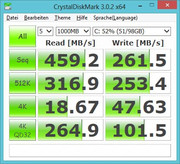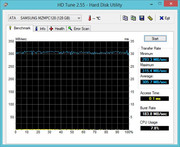Review HP EliteBook Revolve 810 Convertible

For the original German review, see here.
The HP EliteBook Revolve 810 is a convertible aimed at business customers, combining a compact laptop with full tablet functionality. According to Hewlett-Packard, our test device is not only supposed to deliver great performance and superb battery life, but also comes with a sturdy case. It is mostly made from a magnesium alloy, satisfying the US military standards according to MIL-STD-810 for the categories falls, vibrations, concussions, soiling, height and high as well as low temperatures.
The convertible comes in five different variants, being equipped with different CPUs, varying amounts of RAM and mass storage space as well as the availability of a WWAN modem. All systems ship with Windows 8 Pro, although a downgrade to Windows 7 Professional is possible as well. The Revolve also comes with an 11.6-inch swivel-type IPS display which is protected by Corning Gorilla Glass 2.
The following table lists the different models. Pricing starts at 1769 Euros (incl. VAT, ~$2378). This variant has the exact same specifications as the one for 2055 Euros (~$2763) - no mistake, as this refers to a limited offer according to HP.
| Price | 1768 Euros (~$2387) | 1958 Euros (~$2642) | 2055 Euros (~$2773) | 2157 Euros (~$2911) | 2253 Euros (~$3041) | 2321 Euros (~$3133) |
| Processor | i5-3437U | i5-3437U | i5-3437U | i5-3437U | i5-3437U | i7-3687U |
| RAM | 4 GB | 4 GB | 4 GB | 8 GB | 8 GB | 8 GB |
| SSD | 128 GB | 128 GB | 128 GB | 256 GB | 256 GB | 256 GB |
| UMTS | yes | no | yes | no | yes | yes |
Our test device is the one of the limited offer variety. It comes with an Intel Core i5-3437U, 4 GB of RAM, a 128 GB mSATA SSD and a WWAN modem. Like the Panasonic Toughbook CF-AX2 (approx. 2100 Euros, ~$2822), HP's convertible is positioned as a decidedly premium product, being equipped with a sturdy chassis and powerful ultrabook hardware. Due to their feature lists, other less resilient laptops are among the direct competitors as well, ranging from our current champion in the convertible segment, the Sony Vaio Duo 13 SVD1321M2E to other ultrabooks with business ambitions such as the Fujitsu LifeBook T902, the Dell Latitude XT3 or the Microsoft Surface Pro (when combined with its Type or Touch keyboards). Our detailed review will show how these high-end devices fare in comparison to the HP Revolve.
The display of the HP EliteBook Revolve 810 is clad in magnesium. Surprisingly, the alloy doesn't feel smooth to the touch, but rather soft and non-slippery. The panel lid is stable, feeling rock-solid. The swiveling components are pretty torsion-resistant, operating smoothly and without any noise. The touchscreen has been integrated into the chassis without any variable clearances, leading to a great fit and a perception of superb build quality.
The hinge has been made from the same magnesium alloy as the rest of the case, feeling extremely sturdy. It allows the display to be brought smoothly into the desired position without making a single noise. Even after strong vibrations have been applied to the base unit, no wobbling could be noticed. The hinge can be rotated by up to 180 degrees, but only clockwise, not counterclockwise. Doing so and pushing the rear part of the display down on the keyboard transforms the small laptop into a full-blown tablet.
The upper part of the base unit has been constructed from the same magnesium alloy, including the palm rest and the keyboard base. The blackish lower part has been rubberized, making it very easy to grip. The entire base unit feels even sturdier than the display lid. Perfect torsion-resistance, no creaking or cracking noises - if only all laptops were built like this.
When folded up (no matter whether in laptop or tablet mode), both components come to lie perfectly on top of each other, not least because there is a magnet keeping both parts close to each other. The test device measures 285 x 212 x 25 mm large (width x depth x height), weighing 1352 grams. It is thus a bit thicker, but also a bit lighter than what HP claims it to be.
As indicated, HP's engineers have performed hours and hours of tests in order to be able to comply with rigorous military standards. Still, HP does also state that these tests are not to be understood as a guarantee that the convertible will actually be able to withstand similar torture in real life. In addition, Hewlett-Packard doesn't specify which tests exactly have been conducted. At least a spilled cup of coffee shouldn't pose any problems, as the small drains cut into the case witness.
Those who want to be sure might want to take a look at the Panasonic Toughbook CF-AX2, a device which is certified to survive up to 100 kg of weight and falls from up to 75 cm high. Still, it seems likely that the sturdy feel of the Revolve 810 is more than just show. After all, it is no coincidence that the designation of the military standard, "810", makes an appearance in the laptop's name. Overall, we were extremely impressed with its build quality and its sturdiness.
A lot of thought has been put into the placement of the EliteBook's ports. Neither left-handed nor right-handed people should have to battle against cables being in the way as most ports are located at the rear of the notebook. The only disadvantage: Connecting external peripheral devices might become a bit more difficult. Both the power button and the rotation lock are not buttons, but sliding switches, making them less likely to be pressed accidentally.
There are just a few ports, confined to the basics: Two USB 3.0 ports - of which one is capable of charging a tablet or a smartphone even when the Revolve is turned off (this option can be deactivated in the BIOS), a DisplayPort for video output (even HDMI and D-Sub ports can be used with optional adapters), a docking port and a Gigabit Ethernet connector for quick integration into the workplace infrastructure.
Communication
Communication is definitely one of the Revolve 810's specialties, leaving no desires unfulfilled. Next to the Gigabit LAN port made by Intel, there are numerous wireless options.
One of the most important components is certainly the Intel Centrino Advanced-N 6235 Wi-Fi module which is capable of addressing both the 2.4 GHz and 5 GHz bands while being compatible with the IEEE-802.11 a/b/g/n standards. We measured a great effective range during real-life usage. Even 30 meters away from the router (separated by a thick wall), the connection quality was good, with websites loading quickly.
Frequent travelers will be happy to hear about the integrated WWAN modem made by Sierra Wireless, based on Qualcomm's Gobi 3000. Although it does not support LTE, being capped at HSPA+ download speeds of 14.4 Mbps, it does come with the killer feature of being able to connect to almost every cellular network on Earth (called "multi mode design"), supporting GPRS/GSM/EDGE (850, 900, 1800 and 1900 MHz), HSPA+ (800, 850, 900, 1900 and 2100 MHz) and EV-DO/CDMA (800, 1900 and 2100 MHz), much more than what the Toughbook offers. "Pay-as-you-go" services such as HP's DataPass (currently only available in the US) which depend on the actual usage pattern enable easier mobile access to the internet, without the hassle of changing the micro SIM card.
The Revolve 810 also comes with a 0.9 MP (1280x720 pixels) HD webcam for video conferences. Despite of the modest resolution, image quality was actually very decent, especially under low-light conditions. The integrated dual-array microphones work reliably as well, delivering great speech quality with crisp, clear sound, even from a distance of approximately one meter. In addition, Bluetooth 4.0 and NFC are also on board.
Security
In terms of security, the Revolve comes with a number of features, starting from the OS, Windows 8 Pro, which comes with additional security options while also being capable of connecting to networks with a domain. Hard drive encryption can be done with Microsoft's BitLocker or via Absolute Data Protect. In addition, HP offers a number of useful functions such as BIOS Protection, SpareKey, One-Step Logon, DriveLock and HP Client Security for free.
On the hardware side, the 810 ships with a Trusted Platform Module 1.2 and a Kensington lock. That's it - neither a fingerprint reader nor a Smartcard slot are available, not even as an optional upgrade.
Accessories
The Revolve 810 almost seems to ship in a bare box. Next to the device itself, only a power adapter (45 watts, TÜV- and GS-certified in Germany) and three small quick start guides concerning the laptop itself, Windows 8 and mobile internet usage can be found in it.
Things look similarly dire once we get to the optional accessories. Although several accessories can be had, all of them come with a very high price. A replacement battery (HP OD06XL) costs 202 Euros (~$270), the UltraSlim Docking Station (article number B9C87AA) can be purchased for 191 Euros (~$260) and even for the DisplayPort to VGA adapter (8460p), 32 Euros (~$40) has to be paid.
Maintenance
The battery of the HP EliteBook Revolve 810 is easy to unlatch and remove. Beneath, the micro SIM tray can be found. While the laptop can also be used without the battery (as long as the power adapter is connected), this is not to be advised as half the base unit is now missing.
Eight crosstip screws have to be loosened in order to gain access to the other components. Four of them are hidden beneath the battery, while the other four come with rubberized caps.
Now, the mSATA SSD can be replaced with a different one (careful: Windows 8 Pro does not ship on an optical disk, but only as a recovery partition), as can the radio modems.
The convertible is also easy to clean. The fan is handily accessible (and can even be swapped out without too much effort). The one unused memory bank can be equipped with a SODIMM module, bringing the total to up to 12 GB of RAM (the first one is soldered to the motherboard). A second memory module might actually be a worthwhile investment as it would enable dual-channel mode which is known to lead to a noticeable performance boost.
Warranty
The HP Revolve 810 comes with 36 months of limited warranty. Flexible HP care packs allow this to be extended to up to 60 months, including an optional domestic on-site service. This care pack can even be extended to cover more on-site service in more than 100 countries (these can be found on HP's website). In addition, there is also an optional insurance against accidents and theft (in the latter case, HP even takes on the responsibility to track and re-acquire the device via hardware tracking).
Concerning the care pack: The smallest possible variant of one year of extra warranty costs as little as 39 Euros (~$50). The all-inclusive variant for a total of five years, including near-global on-site service, DMR and extended insurance against accidents or theft costs a hefty 755 Euros (including VAT, ~$1016).
Keyboard
Due to the small size of the Revolve 810, no separate numpad can be included. Neither are exotic function keys. HP ships the Revolve 810 with just the basic 83 QWERTY-keys. The slightly conical keys come with a bit of travel and a distinct pressure point. They are also amply sized: 16 x 16 mm, with three millimeters in between. The keyboard base is very pressure-resistant and the keys remain almost silent. Our only complaint: the return key could have been a bit larger.
The upper key row housing the function and F keys has been reduced in size. The numlock and the capslock keys both come with a small white LED, while the airplane mode key (on top of F12) sports an orange LED. The entire keyboard ships with a two-step backlighting system. Our overall impression is very favorable.
Touchpad
The touchpad is 92 x 48 mm large. It feels great and sports superb sliding properties. Input commands are registered reliably and fast, with well-working mouse click areas which offer prompt feedback. Multitouch gestures are supported as well. A double tap in the upper left corner deactivates the touchpad (indicated by an integrated orange LED), while a second double tap reactivates it.
Touchscreen
The capacitive glare-type display can handle up to ten fingers simultaneously. Sliding across it works reasonably well, but the haptics could be better. There is no support for a digitizer.
Due to its rather low resolution of just 1366x768 pixels, all icons and input areas are amply-sized, allowing precise touch controls even while working in Desktop mode. In addition, there is always the physical Windows button below the display, especially useful in tablet mode. At the edge, a rotation lock and the volume rocker can be found.
The Revolve 810 ships with an IPS panel made by LG. Its resolution of 1366x768 pixels (leading to a pixel density of 135 ppi) is not satisfactory given the price point of the device. Many competitors such as the Sony Vaio Duo 13 and the Surface Pro sport Full HD displays. And while the workspace becomes more easily readable, it also becomes much smaller. At least the DisplayPort connector allows connection to external displays which work well with all common resolutions.
The maximum brightness of the display of 434 cd/m² and its brightness homogeneity of 91% are great values. Unfortunately, the peak brightness is reduced to 328 cd/m² while running on battery, but this is still a decent value. No bleeding lights could be found on our test device.
| |||||||||||||||||||||||||
Brightness Distribution: 91 %
Center on Battery: 328 cd/m²
Contrast: 723:1 (Black: 0.6 cd/m²)
ΔE ColorChecker Calman: 4.84 | ∀{0.5-29.43 Ø4.78}
ΔE Greyscale Calman: 3.69 | ∀{0.09-98 Ø5}
42% AdobeRGB 1998 (Argyll 1.6.3 3D)
45.37% AdobeRGB 1998 (Argyll 3D)
65.8% sRGB (Argyll 3D)
43.9% Display P3 (Argyll 3D)
Gamma: 2.6
CCT: 6547 K
Its black levels of 0.6 cd/m² are not superb, not being able to deliver "true" blacks, but they are good enough to allow for a decent contrast ratio of 723:1. Our test device was already well-calibrated in its delivery condition.
Still, this calibration can be improved. Only blue and magenta remain inaccurate, leading to a slight loss in their brilliance. But this is no tragic flaw since the display with its coverage of just 61% of the sRGB color space isn't suited for professional graphics designers or photographers anyway.
During outdoor usage, the reduced peak brightness is quite noticeable. While the screen contents remain readable, doing so does get strenuous over time due to the highly reflective surface. The device remains perfectly usable in the shade.
Good viewing angles are especially important for frequent travelers, even more so in the case of the Revolve 810, since it is perfectly suited for presentations thanks to its swiveling display. HP does deliver in this regard, as even the most extreme viewing angles pose no problems (except for some reflections).
The HP Revolve is based on typical ultrabook internals in order to reach the best possible balance between great performance and long battery life. In our test device, an Ultra Low Voltage CPU is used next to 4 GB of RAM and a 128 GB SSD (a table of the different configuration options can be found in the introductory section of this review article).
Processor
The Intel Core i5-3437U Ivy Bridge dual-core ULV CPU sports a base clock speed of 1.9 GHz and a TDP of 17 watts. It has been manufactured with a 22 nm process, coming with Hyper-threading (thus being able to work on up to four threads at the same time) and Turbo Boost 2.0 technology which allows for a maximum clock speed of up to 2.9 GHz (single-core) or 2.7 GHz (dual-core).
Our Cinebench R11.5 multi-core test results of 2.67 points are pretty much what we would have expected, coming out on par with an Intel Core i5-2430M which is clocked at up to 3.0 GHz, but sports a much higher TDP of 35 watts.
Unfortunately, the laptop never exceeds its base clock speed while running on battery. Due to this performance loss, only 1.88 points is reached in the Cinebench R11.5 multi-core test, no more than what an Intel Core i3-3227U could do.
System Performance
Thanks to the Solid State Drive (SSD), the overall system performance is great. Boot times, navigating the OS - everything felt snappy and stutter-free. The PCMark benchmarks corroborate this impression: 12,636 points in PCMark Vantage is no bad result. In no small part, this is thanks to the SSD, with PCMark reacting very sensitively to the presence of an SSD.
During actual usage, no hiccups occurred. Even converting videos with Intel's Quick Sync didn't seem to be too much of a challenge.
| PCMark Vantage Result | 12636 points | |
| PCMark 7 Score | 4417 points | |
| PCMark 8 Home Score Accelerated | 2700 points | |
| PCMark 8 Creative Score Accelerated | 2333 points | |
| PCMark 8 Work Score Accelerated | 4513 points | |
Help | ||
Storage Devices
A 128 GB mSATA SSD made by Samsung (MZ7PC128HBFU) is used, with just 60 GB of user-accessible storage space remaining after the OS and the recovery partition are deducted. It is also possible to decide in favor of the 256 GB variant or to swap the SSD on one's own.
Samsung's SSD is rather fast, especially when compared to conventional drives and when tasked with reading or writing of tiny 4K data blocks. 17.28 MB/s and 42.80 MB/s (4K read / write) and access times of less than 2 ms are pretty decent.
Graphics Card
The Revolve 810 makes use of the Intel HD Graphics 4000 clocked at 350 to 1200 MHz. It uses some of the RAM (shared memory) which is why it suffers a bit from single-channel mode.
Still, in everyday usage, the GPU is fast enough. Only modern 3D games or 3D CAD applications are too much for it to handle. Its 3DMark 11 result of 601 points lags behind that of its competitors. The Toughbook manages to achieve 9% more thanks to its dual-channel RAM while the Sony Vaio Duo 13 outclasses the Revolve 810 due to its newer HD 4400 card.
The full GPU performance can be accessed even while running on battery, though the clock speed gets reduced to 1050 MHz under continuous load.
| 3DMark 11 - 1280x720 Performance (sort by value) | |
| HP EliteBook Revolve 810 | |
| Fujitsu Lifebook T902 | |
| Microsoft Surface Pro | |
| Panasonic Toughbook CF-AX2 | |
| Sony Vaio Duo 13 SVD1321M2E | |
| Cinebench R11.5 - OpenGL 64Bit (sort by value) | |
| HP EliteBook Revolve 810 | |
| Fujitsu Lifebook T902 | |
| Microsoft Surface Pro | |
| Panasonic Toughbook CF-AX2 | |
| Sony Vaio Duo 13 SVD1321M2E | |
| 3DMark 06 Standard Score | 4546 points | |
| 3DMark Vantage P Result | 2917 points | |
| 3DMark 11 Performance | 601 points | |
| 3DMark Ice Storm Standard Score | 30376 points | |
| 3DMark Cloud Gate Standard Score | 3209 points | |
| 3DMark Fire Strike Score | 414 points | |
| 3DMark Fire Strike Extreme Score | 204 points | |
Help | ||
Gaming Performance
Hardcore gamers will not be satisfied by the HD 4000, and even casual gamers might not be satisfied, since even less demanding games such as Diablo III can only be played smoothly with reduced resolution and everything set to low.
Tablet-optimized games as found in the Windows Store (Fruit Ninja, Solitaire, etc.) pose no problems. The large variety of sensors built into the Revolve 810 makes it even more fun to play such touch-based games.
| low | med. | high | ultra | |
|---|---|---|---|---|
| Diablo III (2012) | 38 | 22 | 19 | |
| F1 2012 (2012) | 28 | 23 | 15 | |
| Total War: Rome II (2013) | 25.6 | 19.4 |
System Noise
The HP EliteBook fares decently in this regard, especially while idle. In this scenario, no more than 28 dB(A) is reached, and sometimes the fan even gets deactivated (if the option "fan always on" is turned off in the BIOS), rendering the laptop completely silent.
Under medium load (such as during 3DMark06), the convertible gets up to 37.2 dB(A) loud. This is definitely audible, but not annoyingly so. Only under long-term full load does it ever reach 40 dB(A), but this will hardly be the case during real-life usage.
Noise level
| Idle |
| 28 / 28 / 28 dB(A) |
| Load |
| 37.2 / 40.3 dB(A) |
 | ||
30 dB silent 40 dB(A) audible 50 dB(A) loud |
||
min: | ||
Temperature
As expected, the temperatures remain rather low while the Revolve 810 is idle, with a maximum value of a lukewarm 35.5 °C at the bottom panel close to the fan vent.
Under load, these values climb to up to 45.8 °C near the center of the keyboard, close to the location of the CPU. Similar temperatures are reached next to the exhaust vents. Most of its competitors are on par with HP's laptop - only the Microsoft Surface Pro manages to stay noticeably cooler at no more than 40.6 °C.
During our stress test, both the CPU and the GPU are working under full load for at least one hour (this is done by running Prime95 and FurMark simultaneously). The CPU then reverts to its base clock speed of 1.9 GHz, while the HD 4000 plateaus at 1050 MHz. Still, the system remains stable at all times.
(-) The maximum temperature on the upper side is 45.8 °C / 114 F, compared to the average of 35.4 °C / 96 F, ranging from 19.6 to 60 °C for the class Convertible.
(-) The bottom heats up to a maximum of 45.6 °C / 114 F, compared to the average of 36.8 °C / 98 F
(+) In idle usage, the average temperature for the upper side is 31.5 °C / 89 F, compared to the device average of 30.3 °C / 87 F.
(+) The palmrests and touchpad are reaching skin temperature as a maximum (34.3 °C / 93.7 F) and are therefore not hot.
(-) The average temperature of the palmrest area of similar devices was 27.9 °C / 82.2 F (-6.4 °C / -11.5 F).
Speakers
The two stereo speakers built into the device offer more than decent sound quality. Highs sound clean and clear although they do tend to over-modulate at high volume. The mids are quite thin and bass is weak, but audible when the laptop is placed on a solid surface.
This should be good enough for small-scale presentations as well as for Skype sessions. The 3.5 mm audio jack leaves a good impression too, working without problems.
Power Consumption
The Revolve 810 requires a surprisingly high amount of power while idle: 7.1 to 10.8 watts. Both the Haswell-based Sony Vaio Duo (3.3 to 6.6 watts) and the Panasonic Toughbook (4.9 to 8.2 watts) need a lot less, the only exception being the Surface Pro (8.0 to 11.8 watts).
Under load, power consumption increases to up to 41.1 watts, slightly less than what the Surface Pro requires (43.2 watts), but considerably more than most of its other competitors. Especially the Duo 13 (max. 31.3 watts) fares far better due to its newer processor generation.
Under extreme conditions, the power adapter is a bit on the small side with 45 watts. Normally, however, it should suffice.
| Off / Standby | |
| Idle | |
| Load |
|
Key:
min: | |
Battery Life
The HP EliteBook Revolve 810 comes with a 44 Wh Lithium-Polymer battery which is supposed to survive for more than 8 hours on a charge. We have measured its maximum runtime using the Battery Eater Reader's Test where the display was set to minimum brightness (21 cd/m²), all energy saving options were activated and all radio modems were turned off. Still, the 7:38 h which we measured under these conditions is not a good result, not even living up to HP's claims. Both the Toughbook CF-AX2 (31 + 17 Wh) and the Vaio Duo 13 (47.4 Wh) beat it by a long stretch with maximum battery life of more than ten hours or even almost a full day respectively.
The minimum battery life has been measured with the help of the Battery Eater Classic Test, setting everything to maximum power consumption, resulting in a value of little more than two hours.
Closer to real-life usage scenarios is our Wi-Fi test where the display is set to 150 cd/m² for all devices, with activated energy saving options, activated Wi-Fi and a browser script which opens a new website every 40 seconds. And again, the 5:15 h of the Revolve 810 is nothing to write home about. Only Microsoft's Surface Pro (4:45 h) dies sooner while many other convertibles offer superior battery life, among them the ThinkPad Helix (7:18 h), Sony's convertible (6:51 h) and the Acer Iconia W700 (6:33 h).
Recharging the battery takes 2:15 h.
Verdict
The HP EliteBook Revolve 810 is definitely no true all-rounder, but rather a decidedly premium convertible ultrabook which happens to be able to take a beating or two. Due to its unusual design, it will definitely attract attention.
It is extremely well-suited for presentations, serving as a great travel companion in today's business world (despite its mediocre battery life) due to its more than decent WWAN modem which is compatible with most cellular networks on Earth.
Its main disadvantage has to do with its premium price - which will likely be too much for the majority of small and medium-sized businesses, especially so since a number of crucial features such as a Smartcard reader have to be retrofitted via third-party offers.
Those in need for a somewhat ruggedized business laptop might want to have a look at the Panasonic Toughbook too. Graphics designers and photographers might be happy with the Sony Vaio Duo 13 which comes with an even better display with decent coverage of the sRGB color space.





